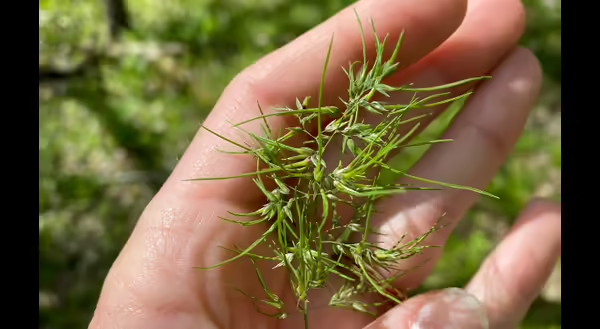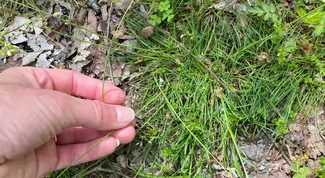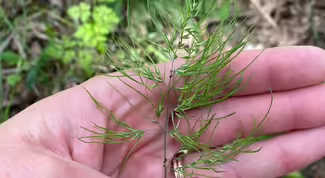
While hiking through an open woodland, I saw a grass that looked different from any other I’ve seen before. I bent down and snapped some pictures, using iNaturalist to check for a quick identification. I was disheartened to see that it was yet another non-native, weedy grass. This one is called Bulbous Bluegrass, Poa bulbosa.
Identifying bluegrasses
Related to Kentucky Bluegrass, which despite the name is not native to the United States, Bulbous Bluegrass is one of 18 different species of bluegrass that can be found in Illinois. Bluegrasses have a few general characteristics:
- Cool-season grasses
- Short grasses often growing in clumps with thin, linear leaves
- Keeled leaf tips (shaped like the tip of a canoe)
- Membranous ligules
- Panicle inflorescences
- About a third of the grasses in this genus found in Illinois are native to Europe and Asia
Telling apart Bulbous Bluegrass
This grass fits all the characteristics listed above: it is a short bunchgrass with thin leaves that have keeled or boat-shaped leaf tips. You can find a tall membranous ligule at the base of the leaf blade. As far as the bluegrasses go, this might be one of the easiest ones to identify if you find it in bloom! The seeds of this grass, held in panicles, are swollen at their base, leading to the name bulbous. One of the pieces of the spikelet, called a glume, is uncharacteristically long and pointy, looking like a grass blade emerging from the base of the spikelet.
This grass is weedy, and can spread in more disturbed areas. If you find it in your garden or lawn, weed it out before it can spread. See its current reported distribution on EDDMapS.
Need a refresher on grass ID terms?
Check out the Grass Identification page on our Grasses website!
Thank you for reading!
Never miss a new post! Subscribe to our email list to get updates each time a new post is available.
Give us feedback! How helpful was this information (click one): Very helpful | Somewhat helpful | Not very helpful
ABOUT THE AUTHOR: Erin Garrett is a Natural Resources, Environment, and Energy Educator for University of Illinois Extension serving Alexander, Johnson, Massac, Pulaski, and Union counties. Erin develops and delivers high impact programming to adults and youth to help them develop an appreciation for natural resources and to empower them to make small changes to positively impact the environment. Erin’s programming focuses on why homeowners should consider choosing native plants, how to support native pollinators, how to identify grasses, how to identify and manage invasive species, and developing an appreciation for prairie ecosystems.


